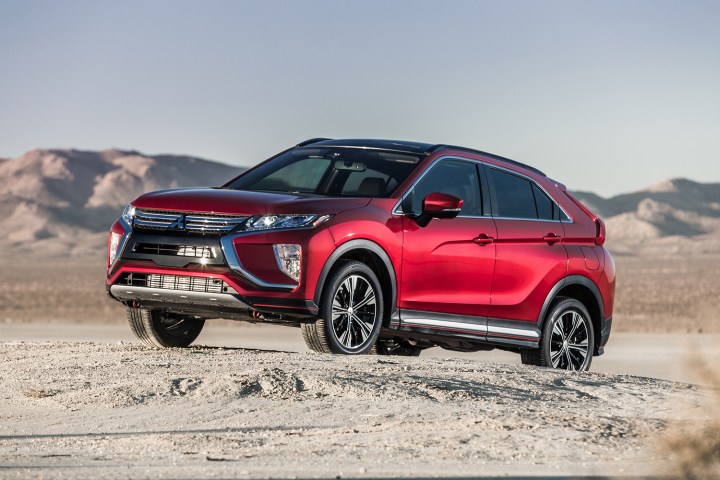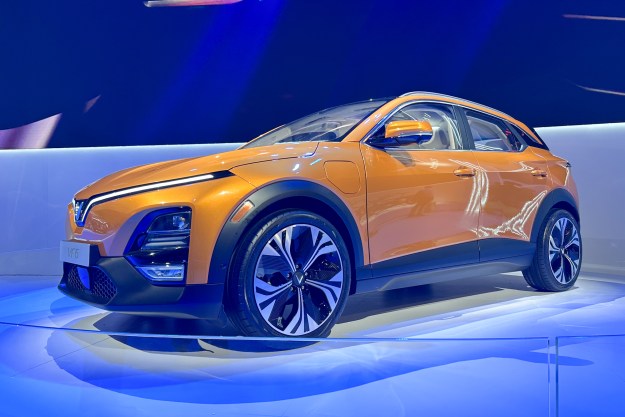
The glory days of the Eclipse, Montero, and Lancer Evolution are long over, but Mitsubishi is looking to reinvent itself. Controlled by Nissan since 2016, the Japanese automaker is looking to use early experience with the tiny i-MiEV electric car and Outlander Plug-In Hybrid into a mass-market line of all-electric and plug-in hybrid utility vehicles.
Digital Trends sat down with Don Swearingen, chief operating officer and executive vice president of Mitsubishi Motors North America, to discuss the challenges of selling electrified vehicles, and how Mitsubishi plans to add more tech to its future vehicles.
Digital Trends: Mitsubishi has gotten back on more buyers’ radar recently, what do you attribute that to?
Don Swearingen: New product and new, aggressive advertising.
One of those new products is the Eclipse Cross, a crossover utility vehicle named after a cult-classic performance car. Have you received any backlash for applying the Eclipse name to a crossover?
“I think you will see both PHEV and electric CUVs coming out of Mitsubishi in the future.”
When we first announced it a year or so ago, we got a little backlash from consumers. But as we have moved forward, they have been able to see the tie in, you know. It’s an iconic name that’s lived with our brand for a long time. It’s the one vehicle name that has the highest brand awareness here in the United States. In other parts of the world it might be Montero or things like that, but here it’s clearly the highest.
Do you see Mitsubishi doing other callbacks to previous models, or is it all about looking forward?
I think it was an easy tie-in for us because, you know, when you look at the Eclipse Cross, it’s a very clean, sharp-looking car. And we thought of that as, that’s what the Eclipse was too. So that’s the tie-in. I think in the future we would look at some of the names, see if it makes sense, and use them. But no, we’re not tied to that strategy going forward.
What are Mitsubishi’s plans for electrification going forward? Will there be any more plug-in hybrids beyond the current Outlander Plug-In Hybrid (PHEV)?
Yes, there will. But let me just say, as you indicated, in the last three months we launched the Outlander PHEV, we’re getting some good response, some good sales volume on that. It’s actually bringing a totally new customer to the brand. These customers are higher household income. But the key is, most of them tell us that Mitsubishi was never on their shopping list prior to this car launch.
Will Mitsubishi’s lineup be heavier on plug-in hybrids, or will there be another all-electric car, to replace the i-MiEV?
As you know, as part of the [Renault-Nissan-Mitsubishi] Alliance, going forward, all of our new product will come out of the Alliance. So I think as part of that, we are using the synergies from Nissan on the fully electric vehicle, and Mitsubishi on the plug-in hybrid vehicle, and using those technologies to advance both of our product lineups in the future. So, I think you will see both PHEV and electric CUVs [crossover utility vehicles] coming out of Mitsubishi in the future.
Will that go both ways? Will Mitsubishi provide plug-in hybrid expertise to Nissan or Renault?
“It costs a lot of money to develop all of this new technology.”
Eighty percent of all vehicles produced for the Alliance will come off common platforms, for both of us. So, I think that technology will be used. And that’s the whole purpose of the Alliance, to try and find synergies where each of us have expertise and try to expand and use that as we develop our products for the future.
As you know, it costs a lot of money to develop all of this new technology. Mitsubishi basically makes one million vehicles a year. Not a lot of cars to spread that development cost. With the Alliance now being over 10 million vehicles [a year], that adds a lot more that we can spread those costs over, and now get it very economical not only for us but the consumer.
Do you see a difference between someone who would go for an all-electric car, versus someone who would go for a plug-in hybrid? Or do you think there is a lot of crossover between those two?
I think there is, and I think that there’s a lot of people that are very environmentally conscious who would love to have a fully electric [car]. But because of lack of infrastructure here in the U.S. and, still, some range anxiety, there are concerns that they have. So, at least at the current time, they look at that plug-in hybrid as a way to get to where they want to go, but also have the safety of having the combustion engine when they run out of charge.
I’ll give you an example of that. At our corporate office, we built a big structure that’s run by solar panels that captures the energy and is used for all of the level 2 and level 3 chargers at our location. We had to segment that facility between 6:00 a.m. and 6:00 p.m. for Mitsubishi only, because we have so many people that come.

I leave work late at night, I’m leaving at 7:00-8:00 at night. When I leave, normally every charger is full with people from other brands. The reason they’re there is because many of them live in apartments or condominiums where they don’t have access to plugs.
We have people that sleep in their car, people that take bicycles out of the back and ride off into the neighborhoods, and I think it goes back to my comment. The infrastructure’s not in place yet, so they’re having to go to all these means. But they’re so environmentally conscious consumers that they’re willing to do that, willing to sit in their car and let it charge.
Beyond workplace charging programs, is Mitsubishi doing anything to grow public charging infrastructure?
We want to make sure they’re initiatives that make sense for our consumers.
DS: You know we’ve done some stuff working with different agencies, mainly handled out of our research and development side of the house. But we support different activities around the U.S., and different initiatives. We want to make sure they’re initiatives that make sense for our consumers.
Do you see any room for performance-oriented electrified vehicles, or performance vehicles in general, at Mitsubishi in the future?
DS: I think there’s a great opportunity. I think our engineers in Japan would love to develop something like that. Even with our [Outlander] PHEV, off the line, it’s got a lot of power. And I think if you can harness that through improvements in not only battery technology, but your electric motor technology. We’ll be advancing that on future PHEVs, and I think as we develop these new technologies it’s going to allow us to move in that direction.

Do you think Mitsubishi could ever adopt the ProPilot Assist driver-assist tech from Nissan, or other systems like that?
We probably could. All of those discussions currently are being handled in Japan, and they haven’t brought that out to the distributors yet, on the future direction on that.
But clearly, as technology, and the demand for this technology grows, we’re going to want to make sure through the Alliance that we all get that technology. And again, as I mentioned earlier, spreading those costs over more vehicles.
Nissan has discussed using ProPilot Assist as a basis for fully autonomous driving. What do you think of that as a future eventuality, especially in the wake of recent fatal Uber self-driving car crash?
Clearly, that was a sad event. But I don’t think we should stop technology advancements because of it. Maybe there needs to be more guidelines in place, but I think the technology will grow. A lot of people are saying it’s going to be sooner than we think.
“[Autonomous driving] is just like plug-in hybrids: we have to educate the consumers.”
I think adapting it is just like plug-in hybrids: we have to educate the consumers. They have to make a decision for themselves if it’s right for them. Some people think autonomous driving is going to change their life drastically; others may think they don’t want to put their life in the hands of technology. So, you have so many different people that have different perspectives of how technology should be part of their lives.
I think clearly the industry’s going to find areas of the country that are willing to adapt quicker, and support the technology, and they [the companies] will focus there. But [it’s] just like true EV technology—in many parts of the U.S., the infrastructure is not in place, but in certain cities or in California, it’s advancing greatly, where I can see more piloting of it there than in other parts of the country.
Editors' Recommendations
- Fake engine noises in electric cars need to die
- Genesis Neolun concept is an electric SUV inspired by tradition
- 2024 Dodge Charger Daytona reinvents the muscle car for the EV era
- Everything is bigger in Cadillac’s electric Escalade IQ
- These new NASA EVs will drive astronauts part way to the moon (sort of)


